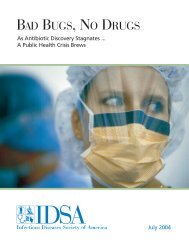Community-Based Surveillance of Antimicrobial Use and ...
Community-Based Surveillance of Antimicrobial Use and ...
Community-Based Surveillance of Antimicrobial Use and ...
- No tags were found...
Create successful ePaper yourself
Turn your PDF publications into a flip-book with our unique Google optimized e-Paper software.
5. Brits, South Africamost prevalent mechanism <strong>of</strong> resistance. Only 2% were non‐susceptible to fluoroquinolones<strong>and</strong> 4.5% to ceftriaxone. Of the six ceftriaxone‐resistant isolates tested for extended‐spectrumβ‐lactamase (ESBL) production, one was positive.Table 5.1: <strong>Antimicrobial</strong> resistance among E. coliNo. tested No. resistant % resistantAmpicillin 212 139 65.6AmoxClav 211 35 16.6Cefuroxime 211 126 59.7 (includes 45.9% intermediate)Ceftriaxone 202 9 4.5Cotrimoxazole 210 109 51.9Gentamicin 212 13 6.1Fluoroquinolones 211 4 1.9Chloramphenicol 48 5 10.4Nitr<strong>of</strong>urantoin 209 12 5.7A large number <strong>of</strong> isolates tested intermediate for cefuroxime, as is depicted in Figure 5.1. Apossible reason for this is that the interpretive break‐points were close to the zone diameters<strong>of</strong> wild type E. coli in the area.Fig. 5.1: Annual percentage AMR rates among E. coli (April 2004 to March 2005)100% resistance806040IntermediateResistant200Ampi AmCl Cefur Ceftx Cotrim Genta Flquin Chloro Nitfur5.3.1.1 Trends in AMR over timeGiven the small number <strong>of</strong> isolates obtained, analysis <strong>of</strong> monthly trends could only beattempted in relation to susceptibility to ampicillin <strong>and</strong> cotrimoxazole, as shown in Figure5.2. On a quarterly basis, variability in susceptibility to these two ABMs was not seen overthe duration <strong>of</strong> the pilot study (Figure 5.3).59




